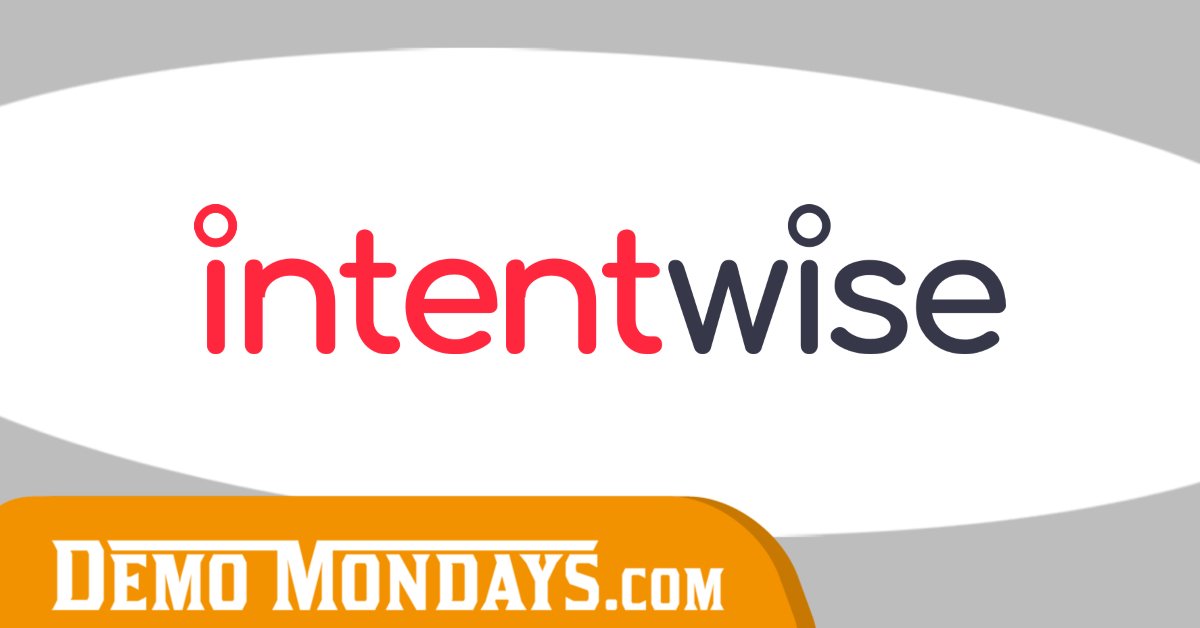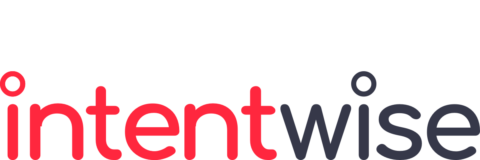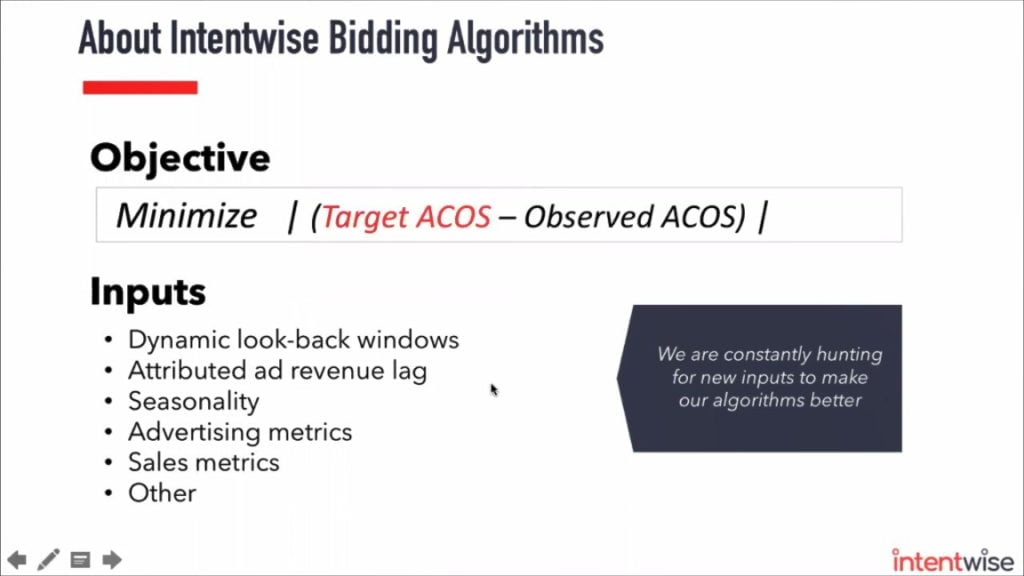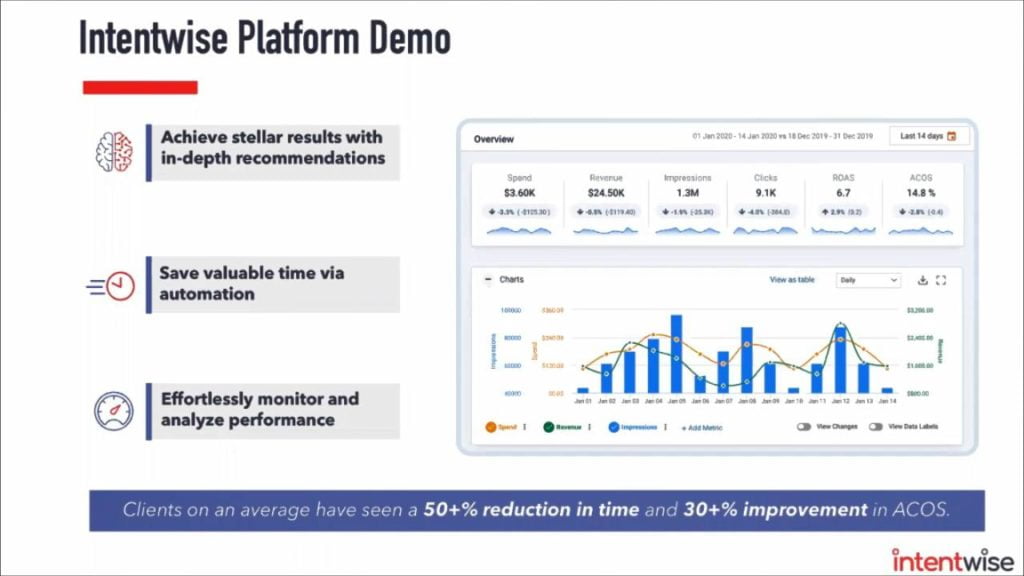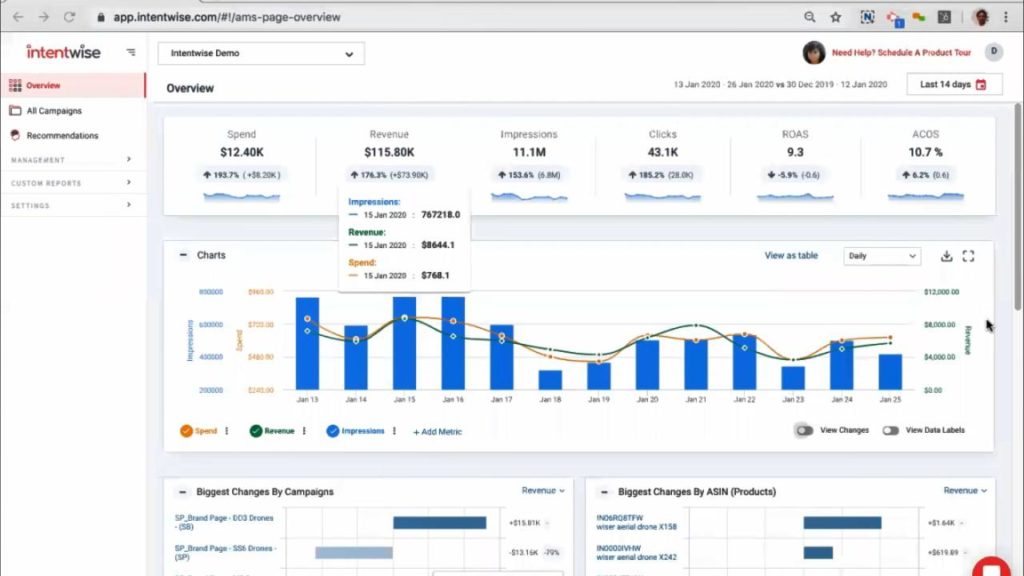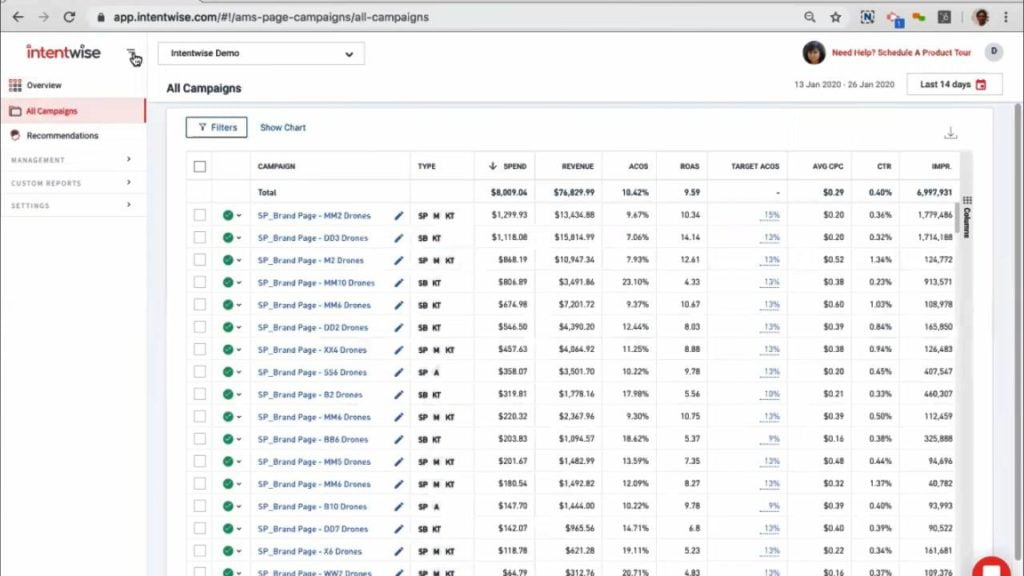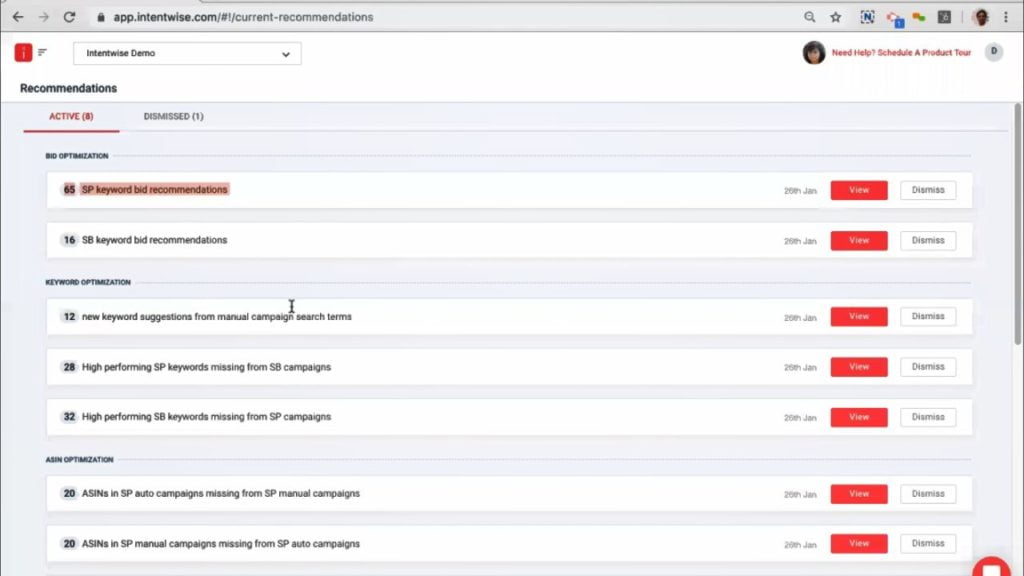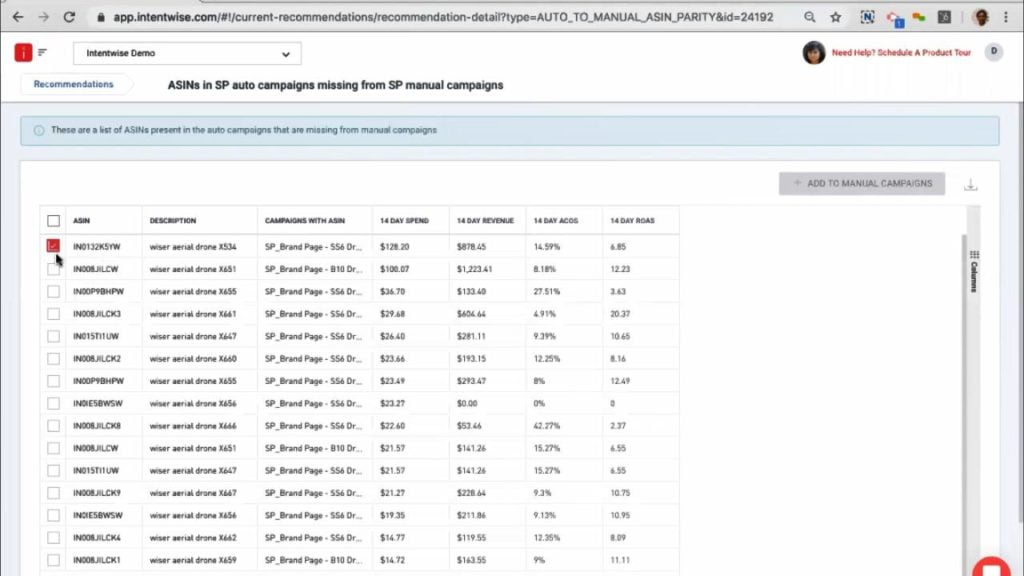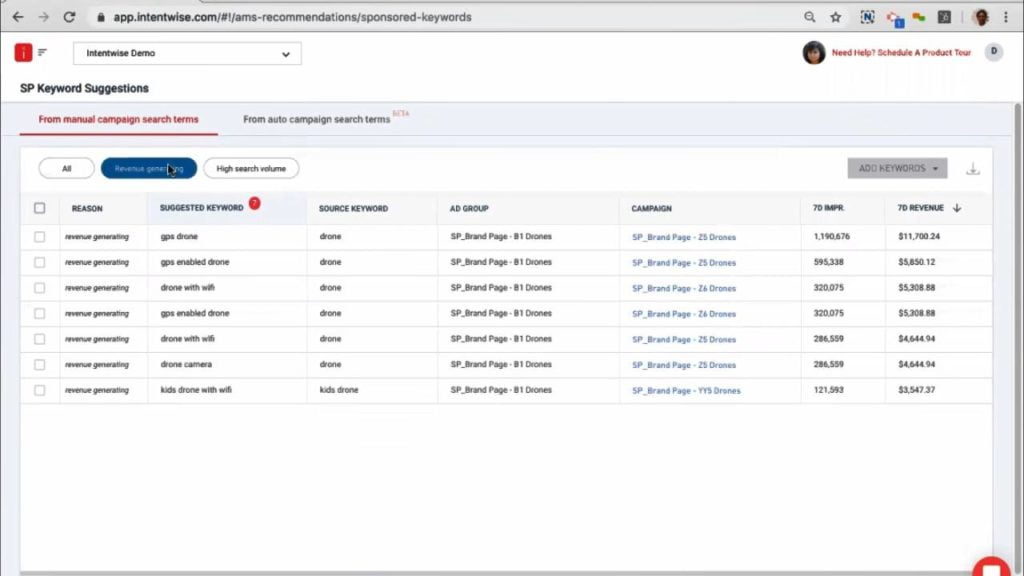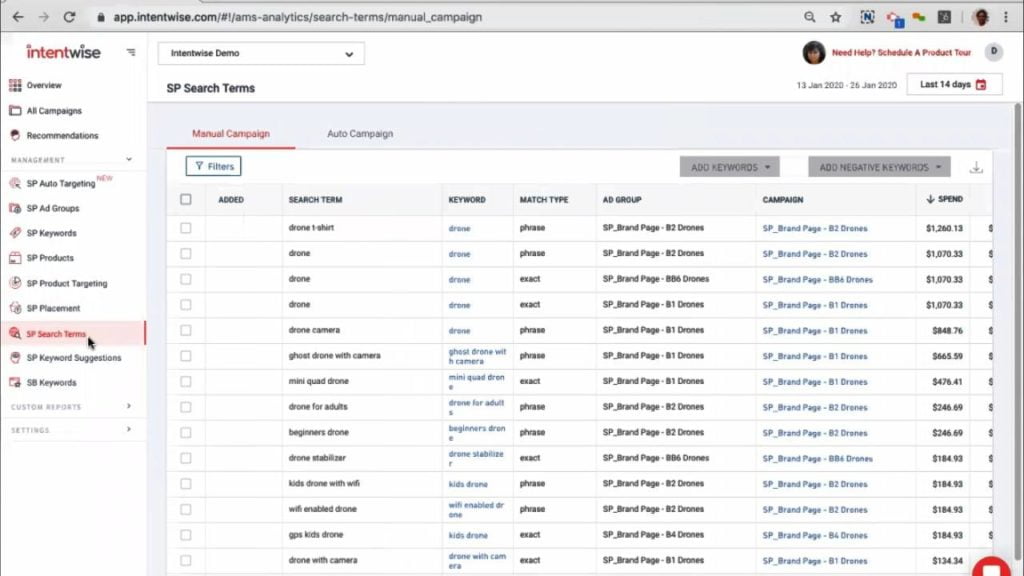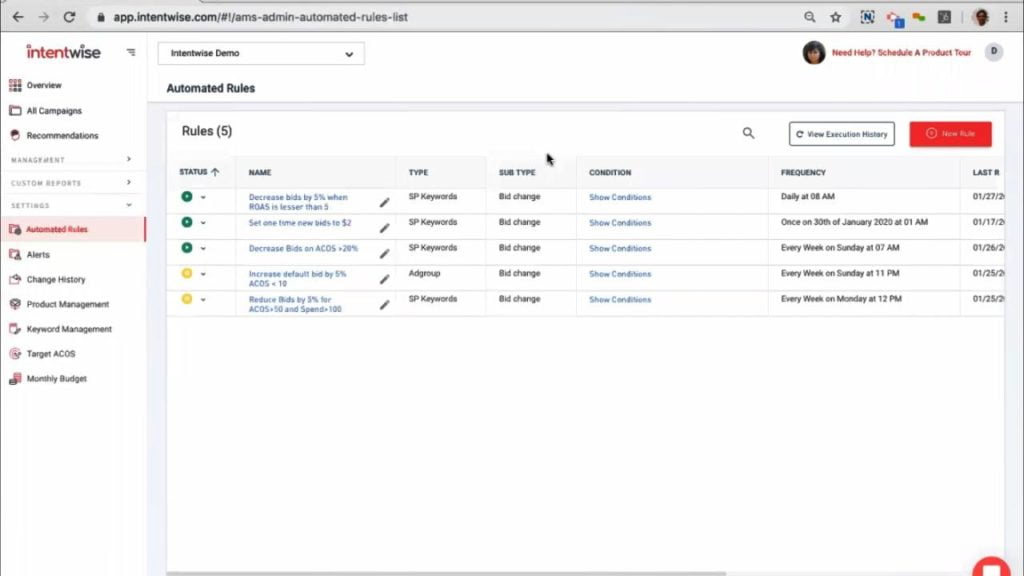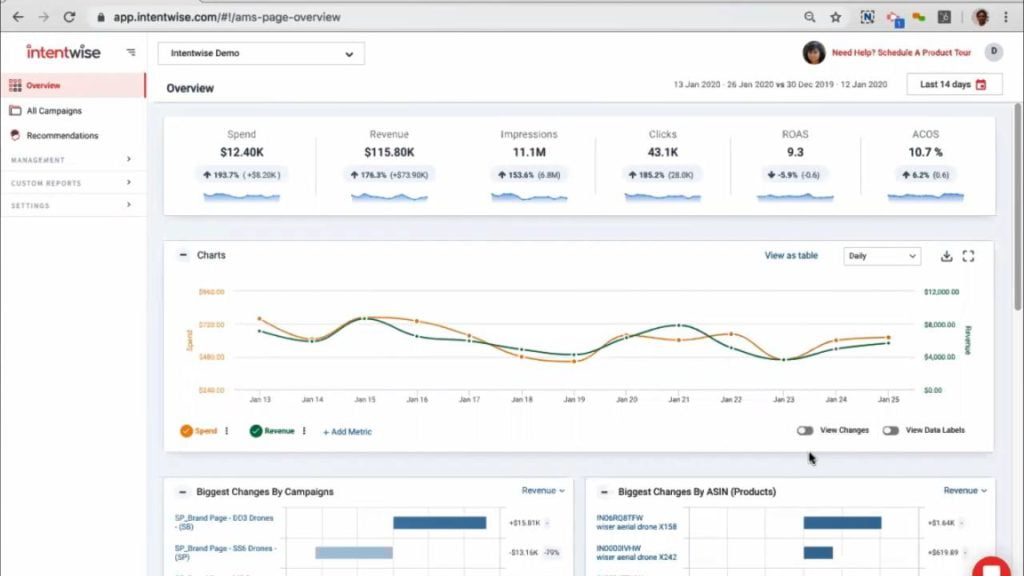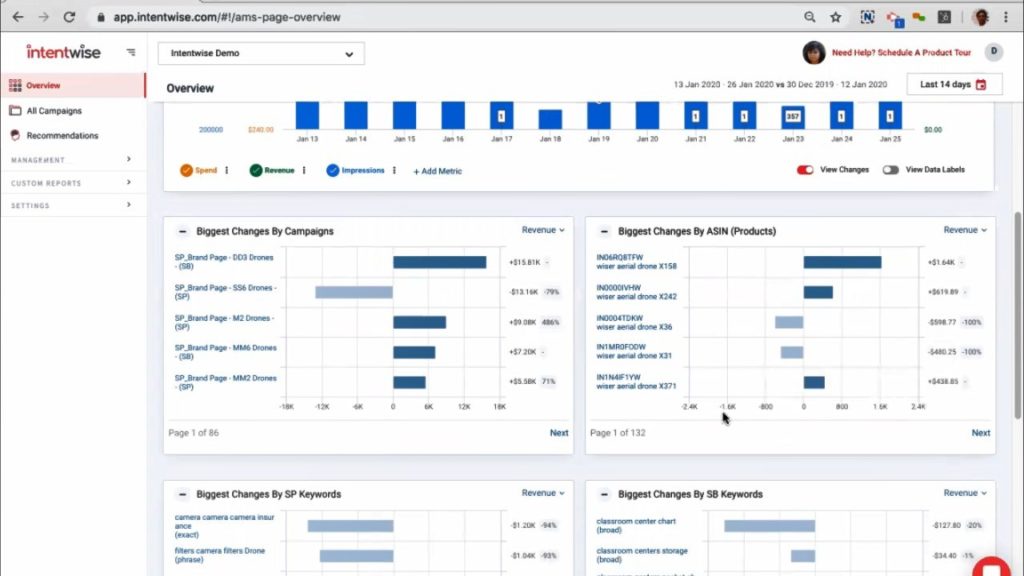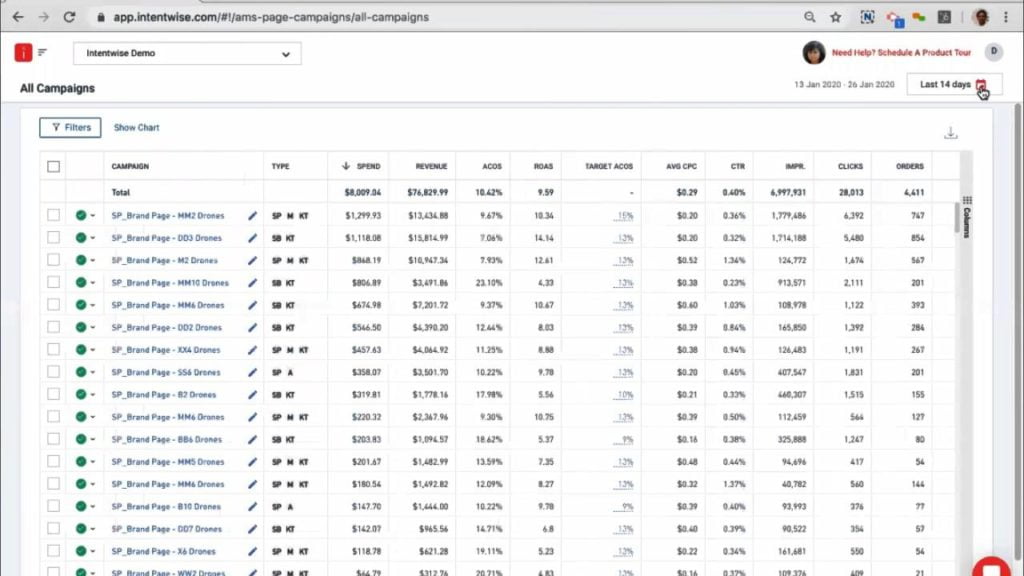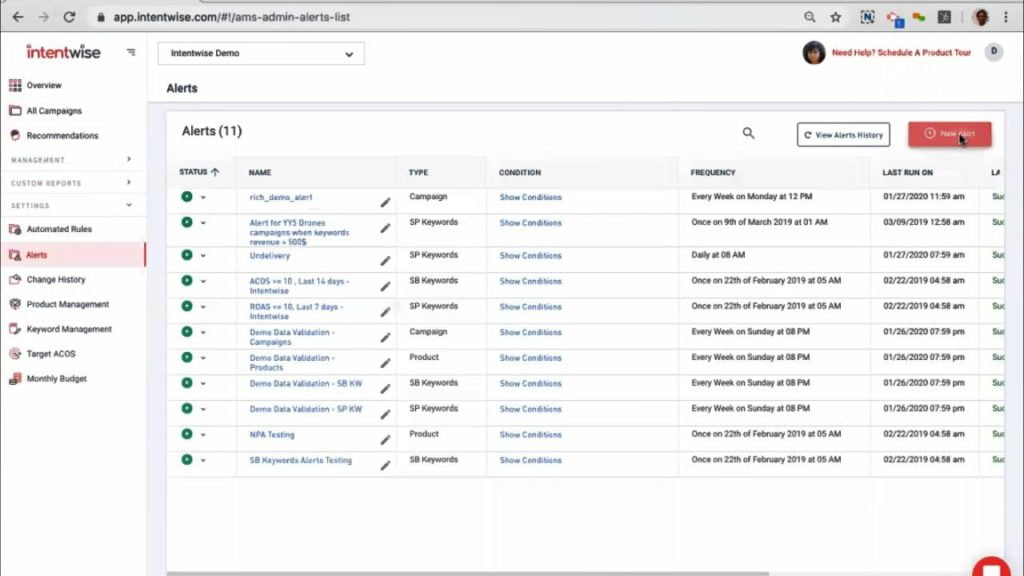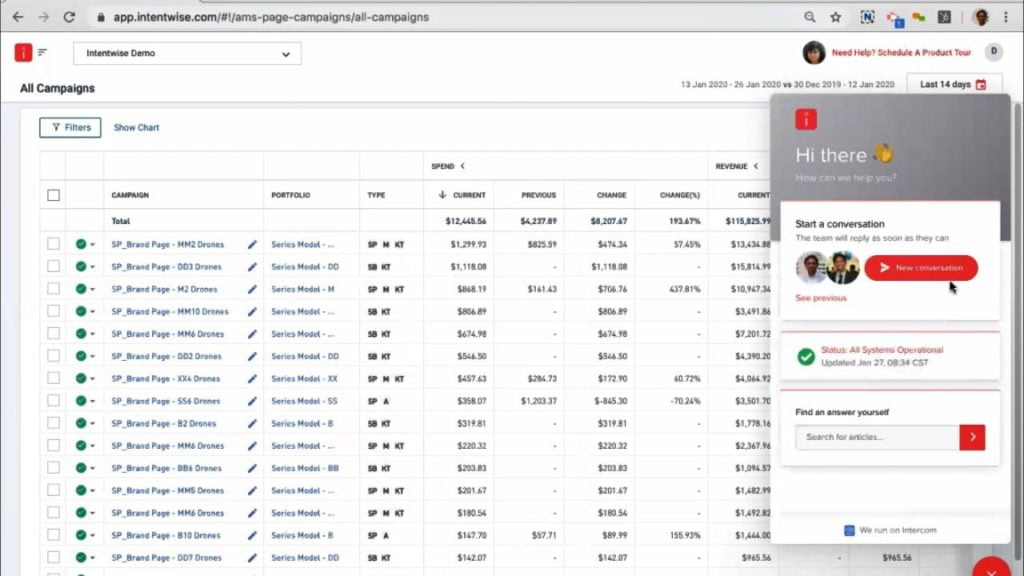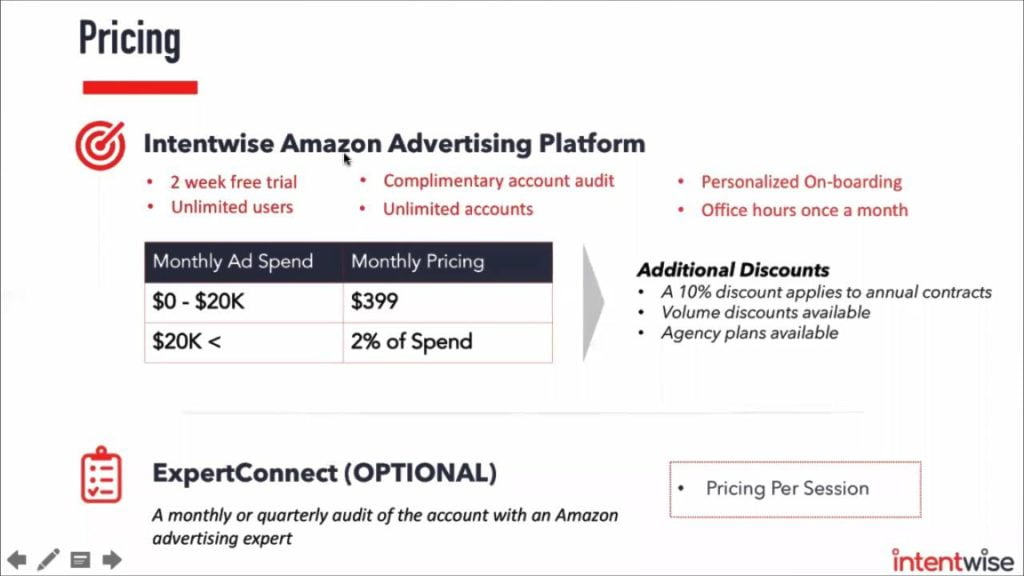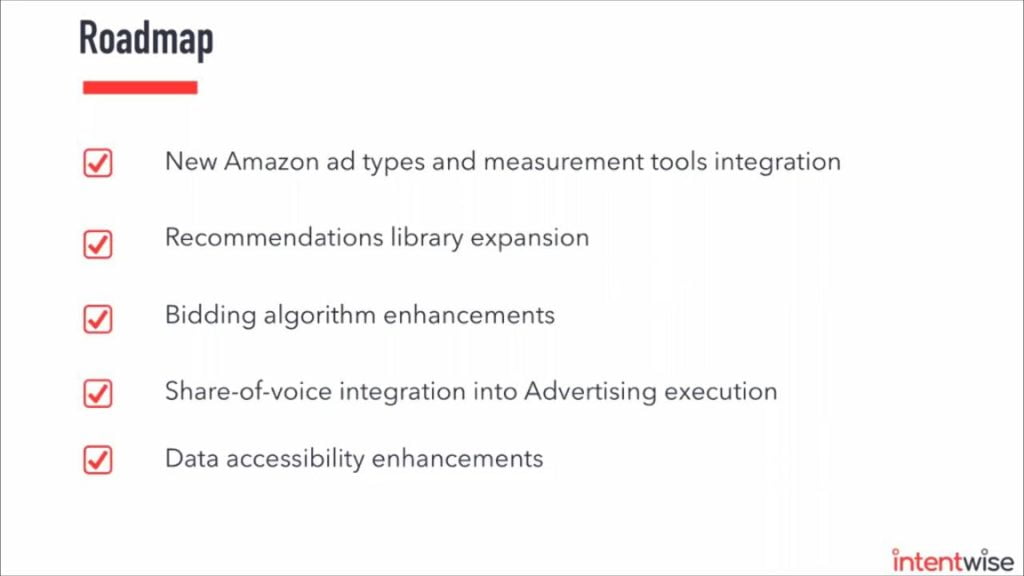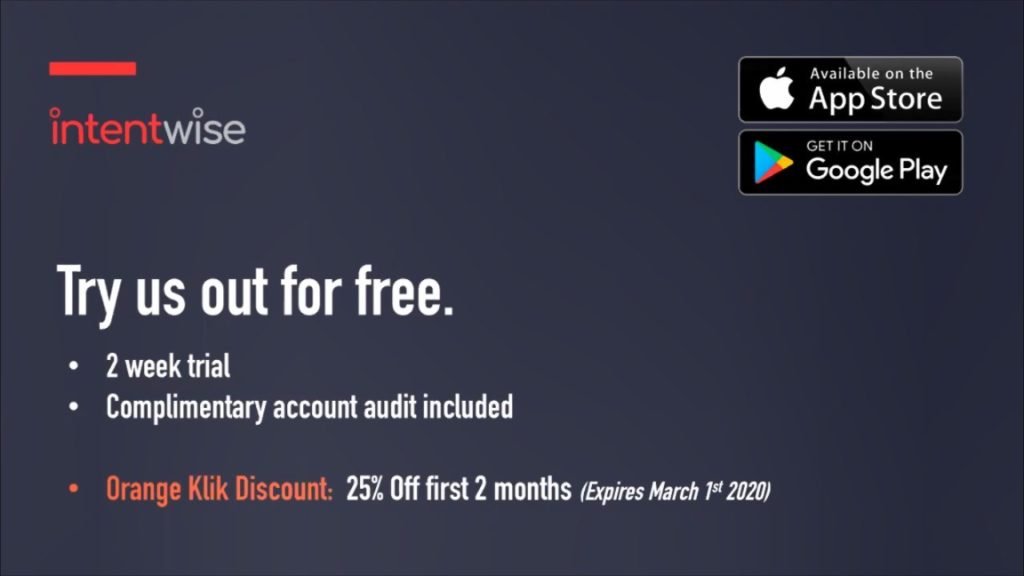Intentwise is an Amazon advertising partner. Intentwise’s technology platform helps Amazon advertisers achieve stellar results and save valuable time.
Intentwise’s comprehensive recommendations span bid management, keyword optimization, product targeting, account structure design, and more. Automation and simplified workflows enable rapid execution of time-consuming tasks such as bulk bid updates, day-parting, and addition of keywords from search terms. With its robust analytics capabilities, monitoring and analyzing performance could not have been simpler. Try them out for free – they offer a 14-day trial.
Intenwise is presented by Sreenath.
List of features covered in this video:
01:58 About Intentwise
03:03 Amazon advertising today
04:51 The Intentwise success formula
05:16 Intentwise technology platform benefits
06:20 Mobile version
06:42 Ad tech platform
07:38 About bidding algorithms
08:41 Intentwise platform demo
08:53 Intentwise ad optimization platform
09:18 Intentwise platform
09:45 Bid management
10:33 Recommendations
11:31 How the flow works
12:17 Keyword solutions
13:00 Simplify actions
13:59 Search terms
14:42 Automated rules
16:37 Capability built in to help you analyze the performance
17:28 Change widgets
18:48 Performance analysis
19:41 Custom time ranges
20:00 Alerts
20:42 Compare feature
22:20 Chatbox
23:25 Pricing
24:53 Roadmap
25:21 Future features
29:18 Special offer – free 14 days trial or get 25% off for your 1st two months with Intentwise. Respond with ORANGEKLIK to our account confirmation email.
Transcript – Walk-through of Intentwise
[00:00] Augustas: Welcome back to Demo Mondays. Demo Mondays is a video series where I ask different Amazon seller software creators to come here and provide the demonstration of their products just like this on the screen. And today my guest is Intentwise.
[00:00] Augustas: Welcome back to Demo Mondays. Demo Mondays is a video series where I ask a different Amazon seller software creators to come here and provide the demonstration of their products just like this on the screen. And today my guest is Intentwise.
[00:23] Augustas: …and Intentwise is presented by the co-founder Sreenath. Hello Sreenath.
[00:26] Sreenath: Hey, Augustas, how are you?
[00:29] Augustas: I am good, thank you. I hope you are well as well. So please, tell us in one sentence – what is Intentwise and what problems does it solve for Amazon sellers?
[00:41] Sreenath: We are an Amazon advertising technology platform and our goal really is to help sellers to get the most value out of their Amazon advertising spend and accelerate their success. And our platform is really all about optimizing Amazon advertising.
[00:58] Augustas: Yeah. It’s a problem which every seller has at the moment, I think. Because my audience is international, can you tell us what marketplaces does your software cover?
[01:10] Sreenath: Sure – North America, Europe, Japan, Australia, and India as well. We certainly covered all of the marketplaces where there is support for Amazon API. Those are the marketplaces we support Amazon advertising on.
[01:25] Augustas: Sounds good. What is your target user? Is it like a beginner, advanced or is it suitable for any kind of seller?
[01:33] Sreenath: I think, as we go through the platform, you’ll probably recognize it. Probably the larger the scale, the bottom model value from the platform, it’s really designed for medium to large scale advertisers. That’s not to say small sellers can benefit from it, but the more you spend, the more your products, the more your campaigns, the more the value from the platform.
[01:58] Augustas: Great. I know that you prepared some little presentation before the real demonstration, so let’s jump to your screen and let’s see what Intentwise is.
[02:10] Sreenath: Absolutely. Let me share my screen. Well, first of all, we just got right into this. Again, Augustas appreciate the time. I wish I was in Spain. I’m in Chicago right now. Like I said, warm and sunny Chicago, but a little bit about Intentwise. We are a company based here in Chicago, as well as Bangalore. What you really all about is helping Amazon advertisers to really accelerate their success. And I’ll talk all about how we enable that. As a team, what we have done is, we have kind of brought three skill sets together: advertising technology, data science and Amazon advertising itself. For example, I personally, I was head of paid marketing at one of the largest travel eCommerce companies in the United States – Orbitz. There are several other folks on the team that come from similar backgrounds.
[03:03] Sreenath: So we have had battered scars that aren’t optimizing advertising spend. In our posts, we used to have a budget of $30, $40 million a year as the advertiser. So that’s the kind of team we have built. And what I’m going to do is just walk you through, just set up the context with a few slides. And today we’ll also do a demo of the platform. So let’s get into this. So when you look at Amazon advertising today, I think we can all agree to what I’m saying here – is rapidly growing. It’s complex, it’s competitive, it’s time-consuming. And the number of levers that are being made available by Amazon is just dramatically increasing. If you look at Q4 alone in 2019, the number of changes that they’ve made is pretty incredible. And I don’t expect that to slow down anytime soon.
[03:56] Sreenath: So the question then becomes – how do you, as a seller or the agency or the advertiser, succeed? And for us, having been seeing this for a very long time, it kind of really boils down to kind of four fundamental things, right? At the end of it, are you targeting the right audience? Are you managing your bids effectively? Do you have a process to analyze information, discover opportunities rapidly? And do you have a process of continuously experimenting and learning rapidly? Because so many things are changing so fast. Every advertiser who has this discipline and this thing working for them is going to be successful. And our job, the way I see it, the mission of our company, Intentwise, is really to help accelerate this process and Institute this on behalf of the advertisers. And question is – how do we do that?
[04:51] Sreenath: We do that – we kind of bring three pieces together: the technology platform, a robust state of the art technology platform, heavy investment in customer support just to help our clients explore every opportunity there is. And there’s also on-demand access to advertising expertise to the advertisers. So we bring these three pieces together in making our client’s advertisers successful. A little bit about the technology platform: there are uniquely three things, three ways in which platform adds value to the advertiser, right? One is – we automatically surfaced really in-depth recommendations. Recommendations aren’t exploiting opportunities and they range from bid management to keyword optimization to ASIN optimization. It’s a long library of recommendations that we leverage. Second is, as you know today, running campaigns can be time-consuming. There’s a lot of workflows we have enabled that simplify life for advertisers. They can do a lot more things in a lot less time. And then lastly, this ability to effortlessly kind of monitor performance, analyze performance and see what is happening there. The platform itself adds value in these three ways. We have had quite a bit of success with the advertisers to date. And the other thing I want to add from a platform perspective is, we also have a mobile version of it.
By the way, it’s free for anyone to download and use. What we do with it is, it’s like having metrics and expertise on the go. You can keep track of advertising metrics. We also push out a lot of educational content. As an advertiser, you have access to that as well and you can download that from the Apple Store and Google Store. It’s called Intentwise.
[06:42] Sreenath: So that’s a little bit about our technology platform. Now it is an ad tech platform. The conversation is incomplete without talking about bidding algorithms and me personally in several of my folks on the team have spent the last decade applying machine learning techniques to data and applying to real-life use cases. Advertising has been one key area. The way we are building our algorithms, when it comes to bidding optimization, the way it works today is, we let our clients define their target ACOS and really what the algorithms are shooting for is minimizing this gap between target and observed ACOS. And the idea of being, if your ACOS is lower than the target, then you’re probably leaving money on the table higher than the target. You probably need to pull back, but the entire function is really about minimizing that gap between target and observe ACOS.
[07:38] Sreenath: There’s a lot of inputs that go into these algorithms. Obviously this is nontrivial. I won’t touch on every one of them, but things like “Dynamic look-back windows” – what do I mean by that? Every keyword has its own amount of data that it’s collecting. Some have lots and lots of data within a day. Some have very little data over a week. This idea of Dynamic look-back windows by keyword accounting for attributes at revenue lag. As you know, in Amazon advertising revenue is click attribution, right? So when you click today and purchases, three days from now, the revenues attribute it to today. So, if you’re just looking at yesterday’s performance today and optimizing, you could be overreacting, right? So accounting for lags and attribute and revenue, which by the way changes over time in a given year, seasonality, is many, many inputs that are going into our algorithms today. And one of our key jobs as I mentioned here, is we go out hunting for inputs in the porch that make our algorithms better. Okay. And show you how this plays out as part of the demo.
Well, that’s a little bit about our bidding algorithms are kind of core to the platform. So let me switch gears here and here we are. This is the Intentwise ad optimization platform.
[08:59] Sreenath: So I’m going to touch on recommendations. I’m going to touch on how execution becomes a lot faster with a platform. I’m also going to touch on how analysis becomes a lot impresed. Keep those three buckets in mind and I’m going to go through that one at a time. So this is the Intentwise platform. I’m going to just begin with a topic that is of deep interest to everybody, which is bid management. The way bid management works: there’s multiple different ways it works in our platform. I’ll show you kind of the simplest way an advertiser can leverage bid management in our platform. So here’s the list of campaigns that are currently up to running at this, by the way, is a demo account. All you have to do as the advertiser is pick a campaign.
[09:44] Sreenath: You’ve got your budget, you set your target ACOS and that’s all you need to do. And there is an option all the way at the bottom that says “Auto apply bid recommendations”. That’s optional. If you were to check that box, the system is automatically changing bids on a daily basis, at a keyword level, trying to optimize that campaign to achieve your target ACOS. And of course, if you don’t set that flag, all it means is, that we do surface the recommendations. But as an advertiser you have the option to review and apply those recommendations. So we give you that flexibility of relying on complete automation, which is augmented automation. Where you moderate your review before you apply the recommendations. So that is as simple as that. Pick a campaign, set a target, ACOS and off you go to the races.
[10:32] Sreenath: When it comes to recommendations, we briefly touched on bid recommendations, but one of the biggest learnings for us over the last 4 to5 years of doing Amazon advertising is, the fact that bid recommendations alone ain’t enough. That’s an important piece, but not the only piece. There’s a lots of other opportunities that often get missed. So for example, we have a very rich set of recommendations. We are surfacing. So here you have bid recommendations. You’ve got new keyword recommendations from search domes and I have to show you what that looks like. You also have things like, this happens all the time and we see this all the time. So if you have an advertiser that has, let’s say 100, 200, 300 products of that advertising, so often we run into situations where they’ll be certainly ASINs missing from certain campaign types and they don’t know it.
[11:24] Sreenath: It is scenario as simple as that to complex scenarios such as bid predictions. And the flow – we have really simplified the flow, for example. So here you are, it’s saying you’ve got 28 cents in auto campaigns missing from manual campaigns. You go there, click view, see exactly what the recommendations are, right? And then you select them, right? And go ahead and add them to your manual campaigns from the platform right here. It’s as simple as that, right? So that’s how the flow works. So you pick your campaigns and you submit, you’re done. So the idea here is, think of it like there is this virtual analyst constantly digging into data so fast and things that when executed result in better performance of campaigns. While we are on this topic, let me also touch on keyword solutions. So for example, you can click on a keyword suggestions to see what these suggestions are.
[12:21] Sreenath: The platform is automatically surfacing such terms that drive revenue but don’t exist in the account, right? So you can literally take these suggestions and apply them to campaigns one or more campaigns. And it’s as simple as that. So lots of rich recommendations followed by an ability to act on those recommendations really, really easily. So someone can spend like 5 to 10 minutes every week and get a lot of optimization work done. Right? So that’s about recommendations. The other topic that I mentioned to you is how do we simplify actions, right? Broadly, there are kind of a couple of ways we simplify actions. One is bulk changes really easy. So whether it’s auto campaigns or product targeting campaigns or sponsor product keywords, bulk bid changes across all of these, become just a lot faster with the Intentwise platform, right?
[13:29] Sreenath: So for example, I can take all my auto targets. You can apply as many filters as you want in terms of performance. I can go edit bits, decrease bids, pick my percentage or amount and hit apply and you’re done. It’s as simple as that. So whether it’s keywords, placements – you name it. We have a mechanism to bulk update so that can save you a ton of time. The other thing we do, for example, Search Term. Search Terms is a big area of focus for anyone that’s optimizing campaigns. We have really simplified workflows around Search Terms. So for example, I can take Search Terms and add them to campaigns straight from here, as positive keywords and or negative keywords, right? I can apply filters that say “Hey, show me all my Search Terms that are generating no revenue at all”.
[14:21] Sreenath: And by the way, I can take these and add them to my campaigns as negative match keywords. So this process of managing Search Terms and finding things to add as positives and negatives is also dramatically simpler. Right? And the last thing I want to show you from an execution perspective is, this concept of Automated rules. So we are unique in this regard where we have this combination of automated recommendations as well as automated rules that you can define based on whatever criteria you might have. So let me show you what a typical automated rule could look like. Let’s say that you want a bit down and all your keywords or pause certain campaigns on a weekend, right? So I can pick my target. Whether it’s keywords or campaigns, I can pick my targets, I can pick my action. In this case, I can say a bit change, I can pick my conditions.
[15:17] Sreenath: So conditions can be portfolios, campaigns, or even a performance metrics such as let’s say ACOS, let’s say ACOS greater than 30%. And I’m just making this an audio, right? And then, I can say “I want to decrease bids on these”. I can pick my percentages. I can also pick my frequency, right? So daily, weekly, monthly. If I pick weekly, I can pick multiple days in a week. I can even pick specific times. So this is where you can also do dayparting. The point is there are a lot of things you can automate based on your own criteria, your own logic, and set those up as rules in the system. So that’s kind of how between bulk updates, as well as automated rules, we really simplify execution, much more. So if you’re someone that has multiple accounts, you could be a seller with multiple accounts or an agency with lots and lots of accounts. We just give you this incredible amount of scalability and and help you extract the value from your ad dollars.
[16:30] Sreenath: The last topic is – there is a lot of capability built in to help you analyze performance really, really easily. I’m going to touch on a few basic ones. So first of all, we tightly integrate change history into performance metrics. So for example, here’s my order, your dashboard. It’s showing me spend the revenue. I can add many more metrics here. Let’s say I want to add impressions, so I can add as many metrics as I want on these charts. But the cool thing is I can actually see exactly what changes were made. So clicking on this will take me to a change history section that tells you who was the user, exactly what change was made on that particular day. So both tracking of chain history and tying it to performance is something we do in the platform.
[17:23] Sreenath: So that’s one thing. The other thing is we have these, all of your dashboards have these change widgets, which is a common question asked all the time – “Hey, what changed?”, right? So you have this view of big movers and clicking on any one of them will help you deep dive into a particular ASIN, a particular campaign or a keyword, so this ability to look high level, but also deep down to any one entity. In your advertising account is something we enabled.
[17:53] Augustas: Can we look inside one of these?
[17:56] Sreenath: Sure. So let’s say this particular race and increased in revenue, just click on that, right? It takes you straight into a tab called SP products and all of the data is filtered down just for that particular ASIN. And then you can see the performance of that ASIN across all the campaigns that is part of them. It’s dummy data, but you see that particular ASIN across all the campaigns and ad groups.
[18:27] Sreenath: And for that particular ASIN, you can add as many metrics as you want. So this ability to deep dive on anyone ASIN, anyone keyword, anyone campaign is super powerful. Is that helped?
[18:41] Augustas: Yeah, of course yes.
[18:42] Sreenath: And then one last thing I want to show you is when it comes to, again, performance analysis. A lot of times you come in on a Monday and say “Hey, what happened to performance last week or prior week?” or “What happened to performance in the last month or prior month?”. And so one of the things we enable is, this concept of compare. I can go to my date widget and say “Compare” all of the metrics. Now, right now, I’ve got a 14 day view. All of the metrics now changed too, so spend is now current, previous change.
[19:26] Sreenath: So you can quickly sort and understand which ones increased in revenue, which ones decreased in revenue, increased in spend, decreased in spend. And by the way, at any time you want, you can drop this into a CSV. People love spreadsheets still, so you could still do that. And then you can also pick custom time ranges, right? So, comparing custom time ranges is another important use case that we enable. So comparing across time periods. And then lastly, this ability to set up, alerts in the system. So no matter what your criteria is, you could set up automated alerts for yourself in the system. So let’s go to alerts for a moment. Just like rules. I can define alerts for myself and be notified at whatever frequency that you would like. So between connecting change histories, being able to deep dive into different entities, comparing performance across time periods, setting up alerts. We really try to simplify your ability to analyze performance and find opportunities.
[20:35] Augustas: Could you go back to what you showed, the compare feature? There was two weeks selected and now stay on this page and there was a column the last current 40 days, 14 days. And there was a previous column. Now it’s full of numbers, but before I had empty cells. When you switched off the compare, there were some columns, some cells, most of cells were empty and some had some values.
[21:12] Sreenath: Yeah. I mean it’s, demo data, but that’s fine. So this just means there was no, so this is spend, right, there was no spend in the previous period on that campaign. That’s a new campaign. So it showed up in the last 14 days. So does that make sense? So if you start on previous, you can see all the campaigns where they was spent the last 40 minutes. Does that answer your question?
[21:34] Augustas: Yes, yes. Now it’s clear. Perfect.
[21:39] Sreenath: Okay. So just to summarize, we are really all about kind of deep recommendations and simplifying the ability to act on those, giving advertisers this flexibility to pick auto application of recommendations, which is applying themselves a lot of rules and a workflow enablement to save you a ton of time. And then also this ability to analyze performance very, very easily. So these are the things we support from a technology platform perspective. And then one thing I forgot to show you is, as you can see in this corner right here, there’s a chat box, right? So anytime there’s a question, you can open that up, start a conversation and somebody out from our side can will respond back. This could be technical questions. They could be any questions you like, but when I talk about integrating support very deeply, this is what I mean. So we are right there all the time ready to answer your questions. And of course, you can also set up product tours, if there’s questions around certain topics within the platform, we can get on a call with you and just walk you through any questions you might have.
[22:56] Augustas: How fast people might expect the support to get back to them?
[23:00] Sreenath: So because of how we are located, we do have 24/7 support, usually pretty quick. And if there isn’t, you will see a notification. Weekends is probably where we are a little bit light, but typically it’s a fairly quick, because of our geographic locations of the team.
[23:21] Augustas: Very good.
[23:25] Sreenath: And then of course, I’m sure, that’ll be a question about pricing. So there’s a couple of things to note. One is that, the platform is available as a SAS platform. It already comes with a two week free trial. The trial also comes with a complimentary account audit. So we do an audit of the account and share findings. We price it at for anyone with a spend less than $20K we charge $399. Anyone about that recharge 2% of spend. That’s how it be our pricing. But there are additional discounts. We do have on a case by case basis – annual contracts have a 10% discount if the volume of spend is much larger, which we run into all the time. There are volume discounts and there’s also some agency plans that we have available as well.
[24:19] Sreenath: This is our base pricing. And then one other thing is to note is we have this service called Expert Connect, which is optional. But a lot of our clients leverage it where they want someone to audit the account and kind of create a roadmap of opportunities on a monthly or a quarterly basis. We do that all the time. Any of our clients, they get a flavor of it when they see the complimentary audit as part of the free trial. So I’m going to kind of speak in kind of broad themes here from a roadmap perspective. The given the pace at which Amazon is moving, we are constantly investing in integrating Amazon’s new ad types. So whether it’s new things on display – advertising, sponsored brand video and display or something that – you know, we are rapidly working through those, we will be the first ones that get rolled out.
[25:11] Sreenath: As you know, Amazon is also enhancing Amazon attribution and there’s of course DSP. So data is always a track on our site that’s all about integrating all these new things that Amazon is introducing. But beyond that, there’s kind of four key teams that we are focused on – the library of recommendations, that I was talking about. So we’re going to continue to invest in surface more and more of modern more than those. Bidding algorithms, I don’t believe there’s ever going to be a stop on enhancing bidding algorithms, like I said before, are all about hunting down more and more inputs, that can enhance these algorithms. Share-of-voice our understanding where a particular advertisers products are ranking – from an organic standpoint and who else is advertising, understanding share-of-voice and integrating that into advertising execution is another area of focus. And the last one is data accessibility. Very soon we are actually opening up our own APIs, because what we have learned is that sellers have different levels of sophistication. Some of them have their own internal ecosystem for analyzing and looking at data. We want to be able to support that. So we had enabling an API infrastructure to help advertisers extract data out very, very easily.
[26:37] Augustas: All right. Actually in the demo, I forgot to ask – how do people switch between the marketplaces?
[26:44] Sreenath: So there is a all accounts view that we support, where you see everything and then clicking on any one of them puts you in the context of that market, that particular account, so that’s how we enabled it. So, is there any questions on the roadmap versus?
[27:00] Augustas: I wanted to ask about API, which is in the roadmap – how can seller use this or it’s intended for some other cases?
[27:10] Sreenath: Yeah, so it’s a simple use case and we’ve had this situation already, right? So if you want to get a bunch of data into a spreadsheet, rather than have your download from 10 places giving you kind of easy access to, access to the API, put your credentials in – a spreadsheet is loaded with all the critical data. That’s one use case. Right? The other use cases is that are more sophisticated sellers that want to bring all that data into their systems and they may have their own reporting infrastructure. So that’s another use case where today we have people that ask us to drop data at an FTP location. We do that, and the point is depending on the sophistication of the seller. There’s lots of these needs. Today we allow download of data, but that also can be painful. It’s really all about helping you get access to lots and lots of different types of data very, very quickly.
[28:14] Sreenath: Does that answer the question?
[28:16] Augustas: Yes. I’m just thinking, if someone has access to API of Amazon directly, I don’t know, maybe it’s not so easy to get the access for sellers? I don’t know.
[28:28] Sreenath: I mean, you can, there’s a lot of work that has to happen integrating to that. And then there is also limitations around how much data you can get at any time. Right? So in terms of duration of data, so we kind of simplify all that for you, right? Like, you don’t want to sit down to write code to access API. No. Like open a spreadsheet, point to something, click a button, you should have the data. So that’s one type of use case. The other type is, people are fairly sophisticated in or they’ve used things like data studio and other reporting platforms and they want this feed of data to be ingested into those. And that’s another type of use cases.
[29:12] Augustas: All right, cool. So you still have one slide to show, right? With some offer.
[29:18] Sreenath: Sure, yeah. Now what I was going to say is, you can try us out for free. The way to get started with us, you can click on the start free trial button on our homepage, set up your account. Everything is ready within 12 hours. And, like I said before, it comes with a complimentary audit. Our apps are actually free for everyone. You can download them, use them, and then it comes to Orange Klik specifically, we’re going to do a 25% off of the first two months. We’ll have that available until 1st of March in 2020.
[30:00] Augustas: So I think we have all the information. Thanks a lot.
[30:04] Sreenath: Thank you. You’re doing some wonderful work, I appreciate the time you’ve taken with us and happy answered any more questions. But again, thank you.
[30:18] Augustas: Thank you very much. Good luck in your business, Sreenath. Bye, bye.
[30:19] Sreenath: Bye.

